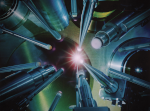This is an online event !
Using laser-driven shock or ramp compression to create extreme states of matter including “Warm Dense Matter” (WDM), i.e. a state between condensed matter and hot plasma in which the electrons start to delocalize from the ions due to pressure and/or temperature, has received significant attention over the last two decades because of its importance for planetary science and tailored materials synthesis. This is, in part, due to the fact that for the first time, brilliant X-ray sources such as XFELs have enabled researchers to perform in situ studies of both the changes in crystal or liquid structure via diffraction and scattering, as well as macroscopic changes via imaging during laser-driven dynamic compression experiments with very high quality. This has resulted in several spectacular discoveries, and in turn, the WDM community both in Germany and internationally has started to grow significantly in recent years.
However, while XFEL sources provide a femtosecond view of the different states created in pump-probe experiments, detailed studies of stress and strain development, as well as the structure of complex crystal lattices or liquids, have been constrained by the limited access to reciprocal space dictated by the lower X-ray energies available at XFELs. In addition, the high flux density of a single XFEL pulse often alters or destroys the investigated sample volumes directly after or even during in situ probing. This can significantly complicate the recovery of potentially interesting new synthesis products or materials seasoned through shock peening. For this reason, the advent of high-energy 4th generation light sources such as ESRF-EBS, APS-U and PETRA IV provide exciting new opportunities to explore laser shock/ramp compression changes in materials with much better access to reciprocal space, both to assess stress and strain developments and to simplify the recovery of unaltered new synthesis products and processed materials. In fact, first pioneering experiments at the APS and ESRF have already demonstrated that synchrotrons are capable of providing single-shot X-ray diffraction and imaging data from samples dynamically compressed with lasers. This will improve significantly because of the improved brilliance of these very stable 4th generation CW light sources at very high energies (> 25 keV). PETRA IV, in particular, can play a leading and pioneering role in this field as it will be the 4th generation source with the highest brilliance and coherence at high energies, providing unprecedented single-bunch, pink beam diffraction and imaging capabilities.
The task of this workshop is to gather researchers from Germany and abroad working in the field of WDM in planetary science and material synthesis and surface engineering in order to gain an overview of the scientific as well as industrial relevant topics and cases one would be able address with a High-Energy shock/ramp compression facility at the new Extreme Condition Time Resolved XRD & Imaging Microscope (ExTReM) at PETRA IV. The workshop will also assess recent advances in laser driver technology with the aim of formulating the optimum setup to be developed/implemented at ExTReM (100-1000 J; > 1 Hz; 1064, 532, 355 nm; 10 - 60 ns ramp; pulse shaping)?

